Co-offending in Canada, 2011
Archived Content
Information identified as archived is provided for reference, research or recordkeeping purposes. It is not subject to the Government of Canada Web Standards and has not been altered or updated since it was archived. Please "contact us" to request a format other than those available.
By Peter J. Carrington, Shannon Brennan, Anthony Matarazzo and Marian Radulescu
[Highlights] [Full article in PDF]
- Prevalence of co-offending
- Factors associated with co-offending
- Co-offending and the seriousness of crime
- Co-offending and laying of charges
- Summary
- Survey description
- Detailed data tables
- References
- Notes
Police-reported crime statistics provide a wealth of information on the number and type of criminal offences committed in Canada each year, yet few studies have looked at the issue of co-offending: crimes committed by two or more people. Traditional crime statistics tend to focus on the number of incidents and the characteristics of offenders or victims, and have yet to explore incident characteristics of crimes committed by groups of people.
Co-offences can be categorized into pair crimes, those incidents committed by 2 offenders, and group crimes, which involve 3 or more offenders. Measuring the nature and extent of co-offending is an area of importance as previous studies have shown that co-offences are, on average, more serious than those involving a lone offender (Carrington 2002). Further, pair and group crimes are evidence of collaboration among offenders and play a role in the recruitment of new offenders (van Mastrigt and Farrington 2011).
Using police-reported information from the 2011 Incident-based Uniform Crime Reporting (UCR2) Survey, this Juristat article addresses three key questions related to co-offending:
- Prevalence: how many incidents reported by police in 2011 were committed by 2 or more people, and how did this vary over time and by jurisdiction?
- Associated factors: which factors (i.e. age, sex, offence type) are associated with increased rates of co-offending?
- Seriousness: are co-offending incidents more or less serious compared to incidents committed by a lone accused? The seriousness of an incident can be assessed using many factors, including the use of weapons during the commission of the offence, and injuries incurred by victims, to name a few.
In addition to exploring these three key questions, this Juristat article also examines other areas related to co-offending, including street gangs, and concludes with an examination of the clearance rates of those accused of co-offences.
Text box 1
Measuring co-offending with police-reported data
This Juristat article presents findings about police-reported co-offending and group crime from the 2011 Incident-based Uniform Crime Reporting (UCR2) Survey, which collects data on all criminal incidents reported to, and substantiated by, Canadian police services.
This report includes only those incidents that were cleared by police (approximately 47% in 2011)—that is, for which at least one accused person was identified—because the identification of the accused person(s) is necessary for the classification of the incident as a lone offence, pair offence, or group crime.
End of text box.
Prevalence of co-offending
Co-offending accounted for 1 in 10 cleared incidents in 2011
Co-offending is relatively uncommon in police-reported crime in Canada. Of the 993,994 cleared incidents reported by police in 2011, just over 1 in 10 (11%) were incidents involving more than one offender. More specifically, 8% were pair offences, involving 2 identified offenders, while 3% were group crimes, involving 3 or more identified offenders (Table 1).
In total, 1.1 million people aged 12 and older were accused of committing an offence in 2011. Of these, 23% or just over 259,000 people were believed to have worked together in the commission of the crime, either in pairs or in groups.1
These findings are similar to the results of a study conducted using data from a large metropolitan police service in England, which found that 10% of incidents cleared between 2002 and 2005 were co-offences, involving 22% of offenders (van Mastrigt and Farrington 2009).
Provincial trends
Previous research has shown that police-reported crime rates in Canada typically tend to follow a geographical trend, whereby the highest rates are seen among the territories and western provinces, and lowest crime rates in the eastern provinces (Brennan 2012). This geographical pattern was not evident among co-offending incidents, as the prevalence of co-offences, and pair and group crimes in particular, varied by jurisdiction (Chart 1, Table 2).

Pair offending was highest in the Northwest Territories (9.9%), Newfoundland and Labrador (9.6%) and Manitoba (9.4%). Group crime however, was highest in Ontario (3.1%), Saskatchewan (3.1%), and Nova Scotia (2.9%). In contrast, pair offences were found to be lowest in Quebec (6.4%) while group crimes were found to be lowest in Nunavut (1.4%).
Incidents of co-offending on the decline
As with police-reported crime rates overall, the prevalence of co-offending in Canada has been gradually declining over time. Between 1995 and 2006, the proportion of co-offences fell 2.3%, from a total of 11.9% of cleared incidents in 1995 to 9.6% of cleared incidents in 2006, with little change after that year (Chart 2, Table 3).2

Pair offending and group crime followed similar trajectories. Pair offending decreased from 9.0% to 7.2% of cleared incidents—a decrease of 1.8%—and group crime decreased from 2.9% to 2.4% of cleared incidents—a decrease of 0.5%.
Factors associated with co-offending
Most co-offences involve only 2 accused persons
Most co-offences that occurred in Canada in 2011 were pair crimes. In total, more than three-quarters (76%) of co-offences involved two offenders, while the remaining 24% involved 3 or more (Chart 3).

In general, group crimes involving numerous offenders were relatively rare. The majority of group crimes involved just three people. Less than 2% of co-offences (less than 0.2% of all cleared incidents) involved 6 or more accused persons.
Females more likely than males to be co-offenders
When females committed crime in 2011, they were proportionately more likely than males to commit offences in pairs or groups. For example, more than 1 in 4 (27%) female accused persons were co-offenders, compared with 21% of male accused. Of these, 19% of female accused were involved in pair offences, and 8% in group crimes. This compares to 13% and 8% of male accused respectively.
Although females were more likely than males to work with others in the commission of a crime, most co-offending incidents were committed by groups comprised solely of males. This is due to the fact that the majority (77%) of people accused of an offence in 2011 were male. In total, more than half (54%) of all co-offences were committed by all-male groups; 12% by all-female groups, and 33% by groups comprised of both males and females.
Although co-offending in same sex groups was highly prevalent among younger co-offenders (both male and female), co-offending with the opposite sex increased more rapidly with age among female co-offenders (Chart 4). Among female co-offenders aged 12 to 17, 24% to 47% co-offended in mixed-sex groups; this increased to 70% and higher among female co-offenders 25 years of age or older. Among male co-offenders aged 12 to 17, 11% to 16% co-offended in mixed-sex groups, with the proportion increasing with age to approximately 40% of male co-offenders aged 30 and older (Chart 5).


Co-offending is more common among youth and decreases with age
Youth (persons aged 12 to 17) were more likely than adults (persons aged 18 years and over) to commit crimes in pairs or groups. More specifically, 44% of accused youth in Canada in 2011 were co-offenders, compared with 19% of adult accused. The differences between age groups are even more pronounced for group crime: 21% of youth accused were involved in group crime compared to 6% of adult accused.
Overall, the prevalence of co-offending decreased with the age of the accused. For example, pair offending decreased from the age of 13 to the late twenties, and more gradually thereafter. The prevalence of group crime fell even more rapidly after the age of 13, and levelled out at less than 5% among accused aged 30 or older (Chart 6). However, the decline in prevalence of both pair and group crimes varied when taking the type of offence into account (Charts 7a to Chart 7f).

The decline with age in the prevalence of co-offending was similar for breaking and entering and for robbery (Chart 7a and Chart 7b). Beginning at high levels among youth, breaking and entering and robbery in groups of 3 or more decreased rapidly with the age of the accused and leveled off at approximately 10% of accused from their early thirties onwards. In contrast, the prevalence of pair offending in these two types of crime decreased with age much more slowly, from a lower level among youth.
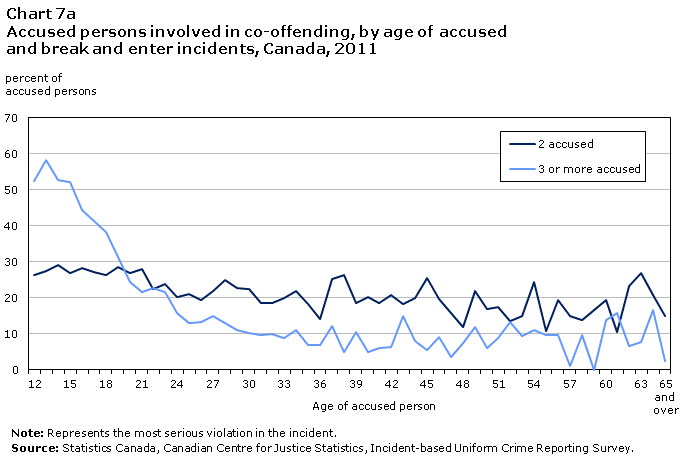
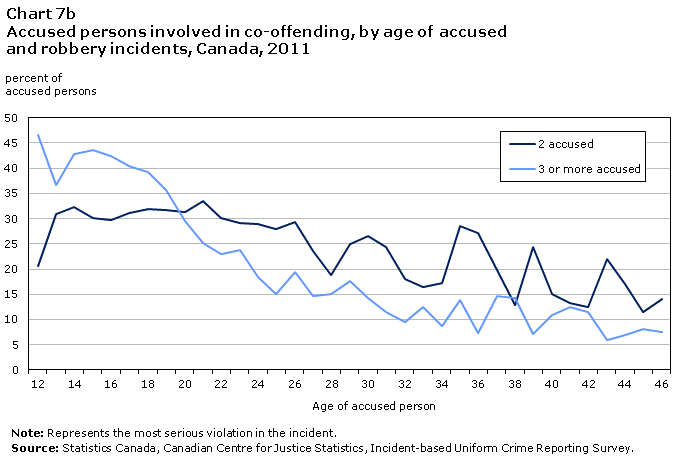
For persons accused of theft of $5,000 or under, the prevalence of group offending was much lower than that of pair offending at all ages. Both pair and group offending were high among youth and decreased rapidly with the age of the accused (Chart 7c).

Few persons under the age of 16 were accused of Criminal Code traffic offences in 2011, with youth aged 12 to 15 accounting for less than 1% of all persons accused of a traffic violation. The prevalence of pair offending and group crime was highest among younger accused, and was found to drop rapidly with age (Chart 7d).
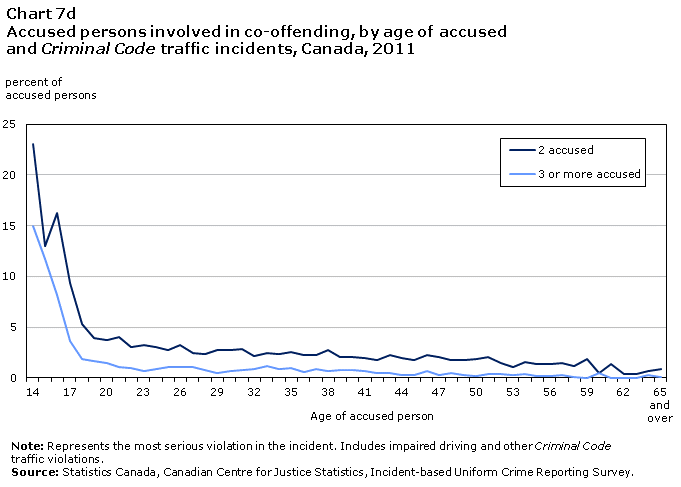
The prevalence of pair offending and group crime changed little with age among persons accused of drug trafficking, importation, or production: the prevalence of both varied around averages of approximately 30% (Chart 7e).
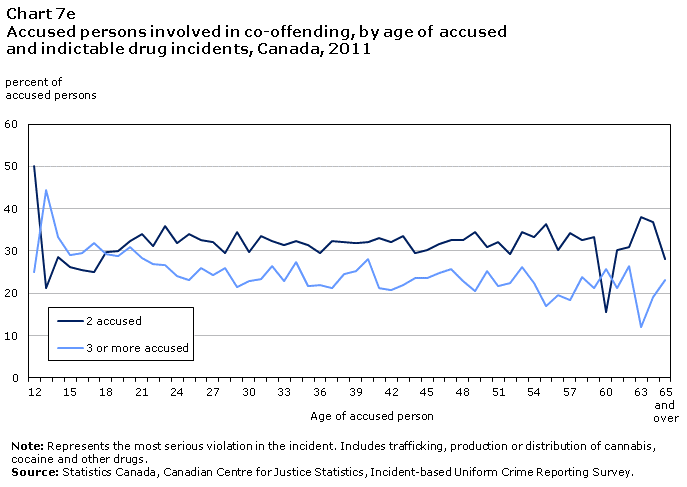
The nature of administration of justice offences (e.g. failure to comply with an order, breach of probation) suggest that they are typically committed by lone offenders. Not surprisingly then, pair offending and group crime were especially rare among persons accused of offences against the administration of justice. Among youth accused of administration of justice offences, 2% to 7% were involved in pair offences, and 7% to 10% in group crimes. Among accused in their twenties to forties, pair offending decreased to 1% to 2%, and group offending to 3% to 5%. The prevalence of pair and group offending was even lower among older accused persons (Chart 7f).
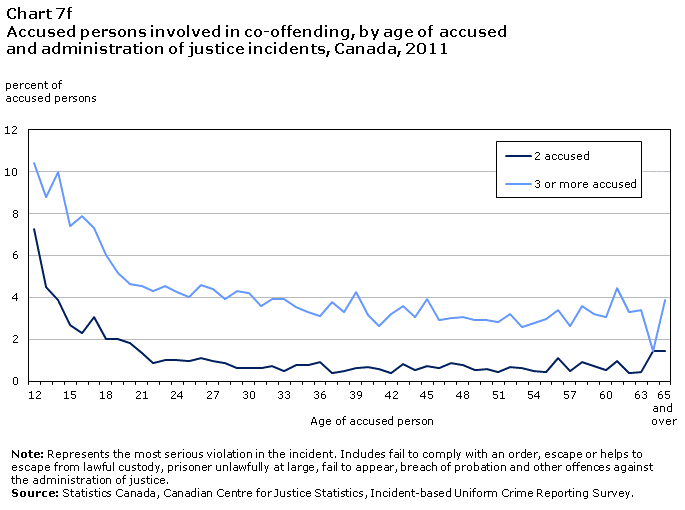
Overall, most co-offenders (67%) who were accused of an administration of justice offence were accused of failure to comply with an order, followed by breach of probation (18%), and other administration of justice offences (11%). Escape from lawful custody, being unlawfully at large and failure to appear comprised the remaining 4%.
While more youth committed crimes in pairs or groups compared to adults, most co-offences were committed by all-adult groups. This is due to the fact that the majority (84%) of people accused of an offence in 2011 were adults. Close to two-thirds (65%) of co-offending incidents were committed by two or more adults, while 22% were committed exclusively by youth aged 12 to 17 years old. The remaining 13% were committed by groups that included both youth and adults. The proportion of co-offending groups consisting of both youth and adults increased with the size of the group, from 10% of groups of 2 to 48% of groups of 10 or more co-offenders (Chart 8).

Text box 2
Co-offending networks
Co-offending networks are formed when offenders repeatedly co-offend with overlapping groups of accomplices (Carrington 2011, Carrington 2014). Co-offending networks may provide evidence of street gang activity, and also of organized crime activity, particularly if the co-offending incidents involve serious offences committed for material benefit (Criminal Code s. 467.1). Research on the relationship between co-offending networks and street gangs and organized crime groups in Canada is currently being conducted by Public Safety Canada and academic criminologists (Glässer et al. 2012; Malm et al. 2011; Morselli 2009; Schwartz and Rousselle 2009).
End of text box.
Co-offending is most common among drug and property-related crime
Co-offending occurred across almost every offence type, from violent offences to other federal statute violations. That said, the prevalence did vary by offence type. For example, both pair offences and group crimes were most common in drug-related and property crimes, and least common in Criminal Code traffic incidents (Chart 9).

For incidents in which all accused were young persons (12 to 17 years old), the prevalence of co-offending was especially high for property crime: 22% of incidents were pair offences and 10% were group crimes (Chart 10).
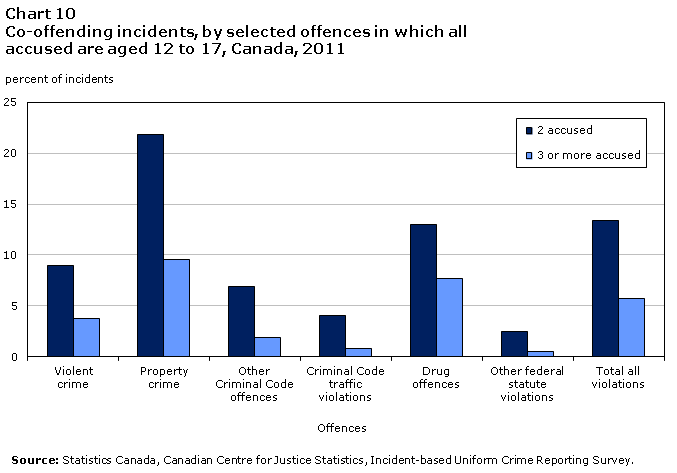
Looking at specific offences, rates of pair offending were found to be highest among incidents of drug trafficking, production and importation/exportation (24%). This was followed closely by robbery (21%), counterfeiting (20%) and arson (20%). With the exception of counterfeiting, group crime was found to be the most prevalent among the same offences (Table 4). The lowest levels of pair offending and group crime were found among incidents of impaired driving, sexual violations against children, offences against the administration of justice, and level 1 sexual assaults.
In incidents in which all accused were young persons, proportions of pair offending and group crime were relatively high in incidents involving breaking and entering, robbery, arson, possession of stolen property and theft over $5,000 and theft of $5,000 or under (Table 5).
Text box 3
Street gangs in Canada
An area of concern for criminal justice policy makers and practitioners is the issue of street gangs, which are considered to be a “structured group of adolescents, young adults and/or adults who use intimidation and violence to commit criminal acts on a regular basis, in order to obtain power and recognition and/or control specific areas of criminal activities.” (Canadian Centre for Justice Statistics 2013). Previous studies have found that there are a growing number of street gangs in Canada which are operating in both major urban centres and smaller communities alike (CISC 2010).
Statistics Canada collects information on street gangs in Canada through the UCR2 Survey. Of the 993,994 cleared incidents reported by police in 2011, 1,086 were believed to have involved street gangs.3 In this small sample, 13% of incidents involving known or suspected street gang members were pair offences and 10% were group crimes, compared with 6% and 3% of incidents involving offenders not known or suspected to be gang members.
End of text box.
Co-offending and the seriousness of crime
The common law treats the commission of a crime by a group as an aggravating factor at sentencing (Ruby et al. 2012). Apart from this intrinsic seriousness, crimes committed by pairs and groups have several characteristics that identify them as more serious crimes overall, including weapon use and injury to victims.
Group crimes most likely to involve a firearm or other weapon
Co-offending incidents were more likely than incidents with a lone accused to involve a firearm or other weapon (Table 6). In general, the use of weapons was more likely to occur among group crimes than pair crimes. For example, a firearm was present in 1% of violent lone-offender incidents and 4% of violent pair offences, with the proportion rising to 7% among violent group crimes. Similarly, knives or other cutting instruments were present in 5% of violent lone-offender incidents and 8% of violent pair offences, compared with 10% of violent group crimes (Table 6).
Victims of violent co-offences most likely to be injured
In 2011, victims of violent co-offences were more likely than victims of violent lone offences to have sustained an injury or death. Victims of violent group crimes were the most likely to have incurred a minor or major injury (61%), followed by victims of pair crimes (57%). This compares to 48% of victims of lone offences. This trend was consistent among almost all types of violent offences, with the exception of kidnapping and abduction, where victims of lone offences were slightly more likely to have been injured in comparison to victims of co-offences (Table 7).
Hate crimes more likely than non-hate crimes to be co-offences
An additional measure of seriousness is whether or not the incident could be classified as a hate crime. Motivated by the hatred of an identifiable group, hate crimes may target race, colour, national or ethnic origin, religion, sexual orientation, mental or physical disability, language, sex, age, or any other similar factor (such as profession or political beliefs).
Hate crimes are considered to be more serious than offences not motivated by hate for a multitude of reasons. For example, previous studies have shown that victims of hate crimes tend to experience more severe emotional effects compared to victims of crime that were not motivated by hate (Dowden and Brennan 2012). Further, the emotional consequences of hate crime can extend past the individual victim, and affect the greater community to which the victim belongs (Lawrence and Fashola 2009).
In general, police-reported hate crimes were more likely than non-hate crimes to be co-offences.4 Overall, 19% of hate crimes were co-offences; 13% were pair crimes, while 6% were committed by groups of 3 or more people. Comparatively, 13% of incidents that were not classified as hate crimes were co-offences, with pair and group crimes comprising 8% and 5%, respectively.
Crimes defined as serious under Criminal Code s. 467.1(1) are more likely to be co-offences
Section 467.1(1) of the Criminal Code defines an offence as serious if it is indictable with a maximum sentence of imprisonment of five years or more.5 Among incidents involving crimes classified as serious under this section of the Criminal Code, 25% were co-offences: 17% were pair crimes and 8% were committed by groups of 3 or more. In comparison, 10% of crimes not defined as serious under s. 467.1(1) were co-offences; 8% were pair crimes and 2% were committed by groups of 3 or more.6
Group crimes have highest seriousness weight
Statistics Canada has computed crime severity weights for different types of offences, based on adult and youth sentencing trends. These weights vary from a minimum of 5.6 for offences such as operating a betting house, to a maximum weight of 7554.9 for the most serious offences of 1st and 2nd degree murder (Babyak et al. 2009).
To assess the severity of co-offences compared to lone offences, the weight of each co-offence was added together and then divided by the number of co-offences to ascertain the average seriousness weight.
In 2011, offences committed by 3 or more people were, on average, more serious than those committed by two people or lone offenders. More specifically, the average seriousness weight for offences committed by groups was 102, considerably higher than offences committed by pairs (76), and offences committed by lone offenders (55) (Chart 11). While the average seriousness of pair and group offences involving only adults or only youth was approximately the same, the average seriousness of mixed-age (adults and youth) pair and group offences was higher.
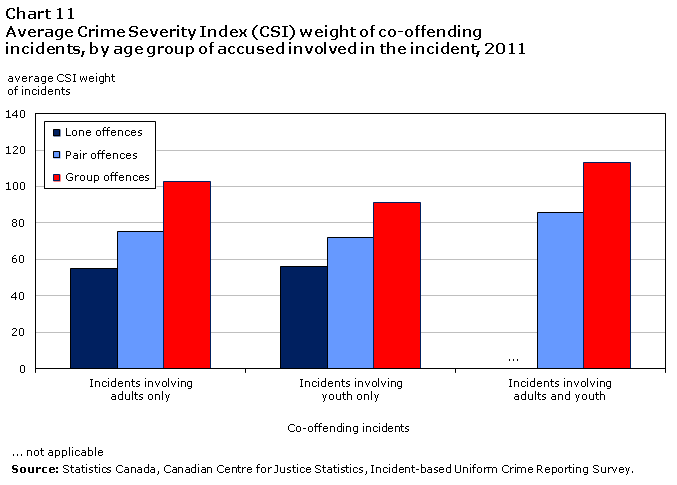
Co-offending and laying of charges
Co-offenders are less likely than lone offenders to be charged
Persons accused in pair or group offences are less likely to be charged (versus cleared otherwise) than persons accused in lone offences: 63% of lone offenders were charged, compared with 49% of pair offenders and 47% of accused in group crimes (Chart 12).
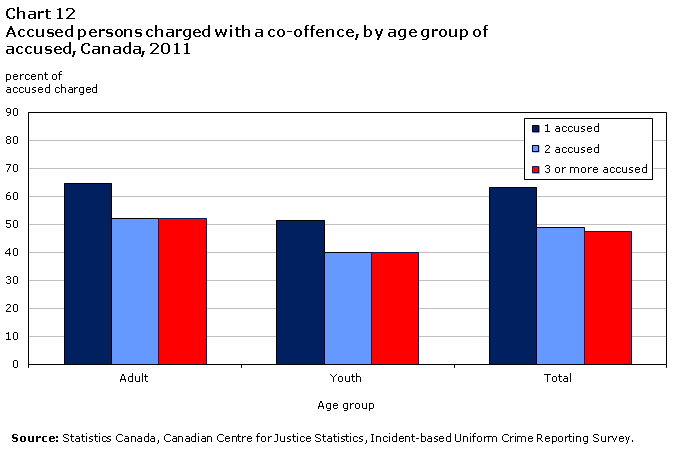
The finding that co-offenders were less likely to be charged than lone offenders may be due in part to the age of co-offenders, and the type of offences they are involved in. Previous studies have shown that co-offenders tend to be younger than lone offenders and, in general, younger accused are less likely to be charged compared to their older counterparts. Further, co-offenders also tend to be involved in offences that are characterized by lower levels of charging (e.g. property offences) (Carrington and Schulenberg 2003; Carrington 1998). In addition, in the case of lone offending, culpability rests solely with the one individual, whereas in co-offences, culpability and other factors influencing charging may vary among the co-offenders.
The proportion of accused charged varied by offence type. For example, lone offenders were more likely than co-offenders to be charged in incidents of child pornography, prostitution, criminal harassment and assault level 1. In contrast, higher proportions of co-offenders were charged in incidents of counterfeiting, abduction and theft of a motor vehicle (Table 8).
Summary
In 2011, co-offending accounted for 11% of cleared incidents reported by police. As seen with crime rates overall, the prevalence of co-offending has declined over time, falling 2.3% between 1995 and 2006, with little change after that year. Most co-offences in 2011 were pair crimes, involving just 2 accused. Group crimes involving numerous offenders (i.e. 6 or more persons) were found to be somewhat rare, comprising less than 2% of all co-offences. Overall, females were more likely than males to be co-offenders, though more than half of co-offending incidents were committed by all male groups. Youth were more likely than adults to be co-offenders and the prevalence of co-offending decreased with age. In general, co-offending was found to be most common among drug and property related crime, particular for incidents in which all accused were youth. Co-offending incidents were more serious, on average, than incidents involving a lone accused.
Survey description
Incident-based Uniform Crime Reporting Survey
The Incident-based Uniform Crime Reporting (UCR2) Survey collects detailed information on criminal incidents that have come to the attention of, and have been substantiated by Canadian police services. Information includes characteristics pertaining to incidents (weapon, location), victims (age, sex, accused-victim relationships) and accused persons (age, sex). In 2011, data from police services covered 99% of the population of Canada.
Detailed data tables
Table 1 Prevalence of co-offending in Canada, incident and accused counts, 2011
Table 2 Prevalence of co-offending incidents, by province and territory, 2011
Table 3 Prevalence of co-offending incidents, Canada, 1995 to 2009
Table 4 Incidents involving co-offending and group crime, by selected offences, Canada, 2011
Table 7 Victims of co-offences, by type of injury and selected offences, 2011
Table 8 Accused charged with co-offending and group crime, by selected offences, Canada, 2011
References
Allen, Mary and Jillian Boyce. 2013. “Police-reported hate crime in Canada, 2011.” Juristat. Statistics Canada. Catalogue no. 85-002. (accessed July 11, 2013).
Babyak, Colin, Asma Alavi, Krista Collins, Amanda Halladay and Dawn Tapper. 2009. The Methodology of the Police-Reported Crime Severity Index. Statistics Canada, Household Surveys Methods Division. HSMD-2009-006E/F.
Brennan, Shannon. 2012. “Police-reported crime statistics in Canada, 2011.” Juristat. Statistics Canada Catalogue no. 85-002. (accessed March 30, 2013).
Canadian Centre for Justice Statistics. 2013. Uniform Crime Reporting Incident-Based Survey Manual. Unpublished.
Carrington, Peter J. 2014. “Co-offending.” In Gerben J. N. Bruinsma and David Weisburd (eds.), Encyclopedia of Criminology and Criminal Justice. New York. Springer.
Carrington, Peter J. 2011. “Crime and social network analysis.” In John Scott and Peter J. Carrington (eds.), SAGE Handbook of Social Network Analysis. London. Sage.
Carrington, Peter J. 2009. “Co-offending and the development of the delinquent career.” Criminology. Vol. 47, no. 4. p. 1295–1329.
Carrington, Peter J. 2002. “Group crime in Canada.” Canadian Journal of Criminology and Criminal Justice. Vol. 44, no. 3. p. 277-315.
Carrington, Peter J. 1998. “Factors affecting police diversion of young offenders: A statistical analysis.” Report to the Solicitor General Canada. (accessed March 30, 2013).
Carrington, Peter J. and Jennifer Schulenberg. 2003. “Police discretion with young offenders.” Report to the Department of Justice Canada. (accessed March 30, 2013).
CISC. 2010. 2010 Annual Report on Organized Crime in Canada. Criminal Intelligence Service Canada. Ottawa. (accessed March 30, 2013).
Criminal Code, R.S.C. 1985, c. C-46.
Dowden, Cara and Shannon Brennan. 2012. “Police-reported hate crime in Canada, 2010 .” Juristat. Statistics Canada Catalogue no. 85-002. (accessed April 15, 2013).
Glässer, Uwe, Mohammad A. Tayebi, Patricia L. Brantingham and Paul J. Brantingham. 2012. Estimating Possible Criminal Organizations from Co-offending Data. Ottawa, ON. Public Safety Canada.
Lawrence, Austin and Sidikat Fashola. 2009. A Preliminary Analysis of the Community Impact of Hate-Motivated Crime. National Conference of the Canadian Society of Criminology. Department of Justice Canada. Ottawa.
Malm, Aili, Gisela Bichler and Rebecca Nash. 2011. “Co-offending between criminal enterprise groups.” Global Crime. Vol. 12, no. 2. p. 112-128.
Morselli, Carlo. 2009. Inside Criminal Networks. New York. Springer.
Ruby, Clayton, Gerald J. Chan and Nader R. Hasan. 2012. Sentencing. 8th ed. LexisNexis Canada. Markham, ON.
Schwartz, Daniel and Tony Rousselle. 2009. “Using social network analysis to target criminal networks.” Trends in Organized Crime. Vol. 12, no. 2. p. 188-207.
van Mastrigt, Sarah B. and David P. Farrington. 2009. “Co-offending, age, gender and crime type: Implications for criminal justice policy.” British Journal of Criminology. Vol. 49, no. 4. p. 552-573.
van Mastrigt, Sarah B. and David P. Farrington. 2011. “Prevalence and characteristics of co-offending recruiters.” Justice Quarterly. Vol. 28, no. 2. p. 325-359.
Notes
- The percent of co-offenders is greater than the percent of co-offences because each co-offence involves 2 or more offenders; whereas, lone offences involve only 1 offender.
- Trend information covers the period from 1995 to 2009. Chart 2 is based on selected police services that have reported consistently to the UCR since 1995.
- Information on street gangs excludes police services reporting to the UCR2.2 Supplemental Survey. In 2011, the police services providing information to the supplemental survey were Toronto, Calgary, Quebec, and Saint John.
- In 2011, there were 1,332 hate-crime incidents reported by police, however information on the accused reflects data reported by police services covering 86% of the population of Canada. It does not include police services reporting to the UCR2.2 Supplemental Survey. In 2011, the police services providing information to the supplemental survey were Toronto, Calgary, Quebec, and Saint John. For more information, see “Police-reported hate crime in Canada, 2011” (Allen 2013).
- Each offence in the Criminal Code and other similar statutes is classified as indictable or summary, or both. Summary conviction offences are generally less serious, have shorter maximum sentences (generally a maximum of 6 months imprisonment), and the procedure for prosecuting them is relatively simple. Indictable offences are generally more serious, have longer maximum prison sentences, ranging from 2 years to life, and are prosecuted by a more complicated procedure. Many offences are designated as summary or indictable, at the option of the Crown. These are generally known as “hybrid” or “dual-procedure” offences.
- Some incidents could not be classified according to the definition in s. 467.1(1) of the Criminal Code because the most serious violation in the incident had a UCR code that includes an indictable offence with a maximum sentence of 5 years or more and other offences that do not meet this criterion. Among these unclassified incidents, 8% were pair crimes and 3% were committed by groups of 3 or more.
- Date modified:
